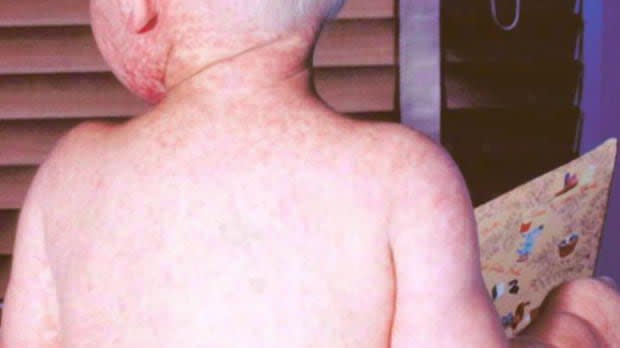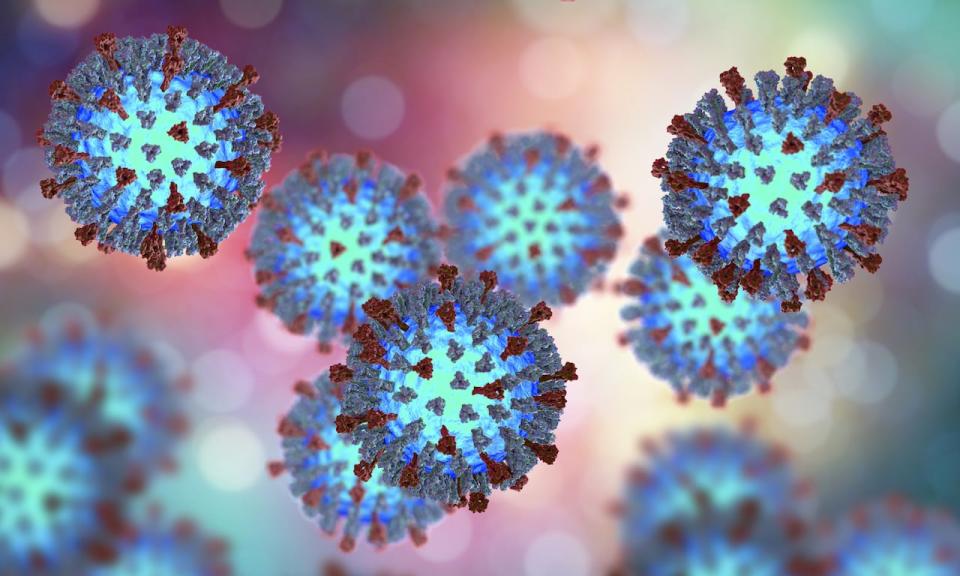N.B. keeps watch for measles, urges vaccines, as European cases surge

New Brunswick Public Health officials are keeping a close eye out for measles, given the surge of cases in Europe and some recent confirmed cases in Canada.
There were 42,200 measles cases across Europe in 2023 — a more than 40-fold increase from the roughly 1,000 cases in 2022, the World Health Organization (WHO) recently announced. December alone saw more than 20,000 hospitalizations and at least five deaths.
Last week, Montreal health officials confirmed a case of measles, likely contracted during a trip to Africa. Saskatoon also had a travel-related case in January.
Measles is a highly contagious disease characterized by a rash. It can cause serious illness and complications, including death. The virus is transmitted through the air when an infected person breathes, coughs, sneezes or talks, or by direct contact with infected nasal or throat secretions.
"The Public Health Agency of Canada (PHAC) and Public Health New Brunswick are aware of large increases in measles cases and outbreaks in many regions of the globe, including in European countries," said New Brunswick Department of Health spokesperson Sean Hatchard.
"These increases of cases and outbreaks are concerning and have been attributed mainly to decreases in immunizations that occurred during the COVID-19 pandemic," he said in an emailed statement. The pandemic disrupted routine immunization efforts worldwide.
Rise in vaccination rate
Hatchard said Public Health has an immunization-awareness campaign and "continually encourages everyone to ensure they are up to date on their vaccines."
He did not provide current measles vaccination rates among New Brunswickers, but said "approximately 91.7 per cent of New Brunswick students entering school [in 2022-23] were immunized with a measles-containing vaccine.
"This was higher than in the pre-pandemic 2019-20 school year when 84.9 per cent of students entering school were immunized," he said.

A 3D illustration showing the structure of measles virus. One person with measles can spread it to an average of 12 to 18 others, research suggests. (Shutterstock)
The figures cover only children eligible to start kindergarten and only those with proof of immunization, according to the department's report on school immunization.
Nearly 30 per cent of students had incomplete records, and did not meet the immunization requirements for school entry through vaccination, medical exemption or parental objection, it said.
According to experts, at least 95 per cent of the population must have immunity to the virus — either through vaccination or prior infection — to prevent an outbreak.
No cases in N.B. in 5 years
The last measles outbreak in New Brunswick occurred in 2019 in the Saint John region. It lasted more than two months, with a total of 12 cases confirmed.
No cases have been reported in the province since then, said Hatchard.
Health-care providers, hospitals, laboratories, schools and child-care centres must immediately notify Public Health of any measles cases.
"Canada generally has high vaccination rates against measles, but there are communities and regions where vaccination rates are low. Measles cases and outbreaks still happen in Canada, as measles is present worldwide and travellers who are not fully vaccinated may bring measles into Canada," he said.
Vaccination urged
In New Brunswick, children are routinely immunized with two free doses of the measles, mumps, rubella and varicella (chicken pox), or MMRV, vaccine at 12 months and 18 months of age.
"Being fully vaccinated provides almost 100 per cent protection," Hatchard said.
People born in 1970 or later who have not received two doses of MMRV vaccine should contact their health-care provider to be immunized, he said.
Adults born before 1970 are generally considered immune, through previous exposure to the virus.
"However, there are some people, such as travellers, who should have a measles vaccine no matter their age," said Hatchard. "Your immunization provider can help determine if you are well protected against measles."
Besides vaccination, other measures to help reduce the spread of the virus include staying home when you're sick, covering your nose and mouth when coughing or sneezing, disposing of soiled tissues, washing your hands well, and not sharing eating utensils, food or drinking cups.
Can incubate up to 3 weeks
It can take up to 21 days after exposure to the virus for symptoms to appear, according to the Public Health Agency of Canada, and people who are infected can spread the virus to others before they develop symptoms.
Research suggests that one person with measles can spread it to an average of 12 to 18 others.
Initial symptoms may include a high fever, runny nose, cough, and red, watery or sore eyes. Tiny white spots may appear on the inside of the mouth two to three days after symptoms begin. A red blotchy rash also appears on the face within three to seven days, then spreads to the rest of the body.
Complications can include ear infections, pneumonia, blindness and swelling of the brain, which can cause seizures, deafness, brain damage or death.
Most people are sick for up to 10 days and then recover completely.
If contracted during pregnancy, it can cause miscarriage, premature labour and low birth weight.


